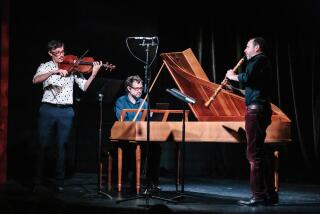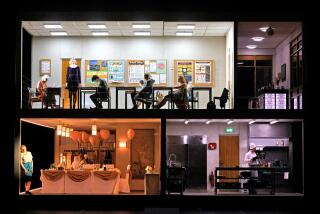MUSIC REVIEW : Southwest Chamber Society Unites Centuries
- Share via
Friday in Pasadena Presbyterian Church, the Southwest Chamber Society dared ask the musical question: What do Claudio Monteverdi (1567-1643) and Luigi Nono (1924-1990) have in common, besides Italian heritage? Is it possible to make a smooth transition from the lucid timeless elegance of the Renaissance master and the cerebral, atonal strategies of the modernist?
Somehow, the concert made the programmatic leap over three centuries with integrity intact. One could point to the rationality of approach between early music and much 20th-Century work, leaving out the emotive gustiness that reached its peak in the 19th Century.
As it turned out, another part of the connective thread was supplied by the venue itself. Monteverdi’s music, by divine right and historical precedent, plays well in a resonant chapel such as the Pasadena church, with its vaulting ceiling. On Monteverdi’s secular and sacred music, soprano Mary Rawcliffe sang boldly--if occasionally faltering in pitch--confidently accompanied by lutenist James Tyler and viola da gambaist Robert Tueller.
In a very different way, that spacious cavity complemented Nono’s spare and chilling “ ‘Hay que caminar’ sonando,” the composer’s final work and the most memorable piece on this program. Here, violinists Peter Marsh and Annie Chalex gradually moved among multiple music stands, suggesting spatial and minimalist theater aspects.
They laid out spectral long tones, slathered in a slow vibrato interspersed with sudden gruff outbursts like unsettled spirits floating up into the space. Based on a very dismantled Verdi motif, the work left an impression of charged-up solemnity. Enigma was not far behind.
In this program, the middle ground was represented--oddly enough--by the music of Arnold Schoenberg, via his 1905 String Quartet No. 1. This dates from the composer’s era of transfigured romanticism, before he began tinkering with the molecular makeup of Western music. In this long, chameleonic piece, played with purpose here by Marsh and Chalex, violist Jan Karlin and cellist Roger Lebow, it’s as if the composer looked in a cracked mirror at the century just passed and created a Cubist portrait thereof.
Underscoring the evening’s century-leaping design was the basic notion that music--music worth knowing--knows no borders of style or epoch. We have more in common with ancestral wisdom than we sometimes care to admit.
More to Read
The biggest entertainment stories
Get our big stories about Hollywood, film, television, music, arts, culture and more right in your inbox as soon as they publish.
You may occasionally receive promotional content from the Los Angeles Times.










